Dwelling, built according to the principles and laws of the traditional Japanese house. The source material is a typical three-bedroom apartment in the house of the P-3M series.
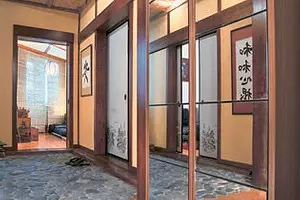
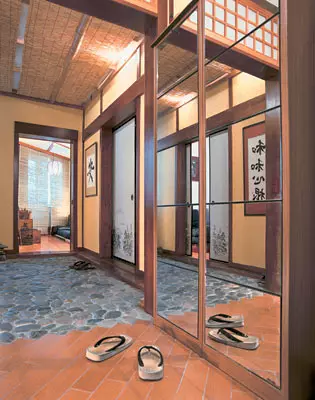
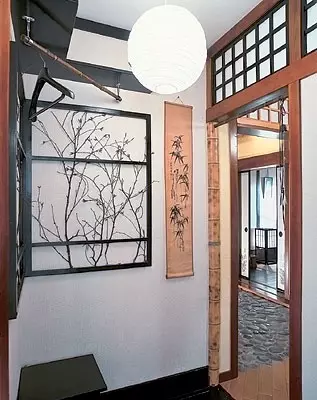
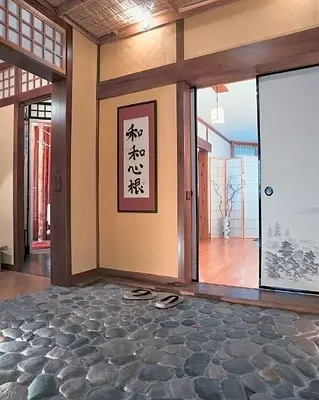
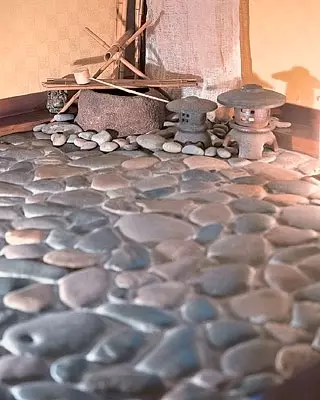
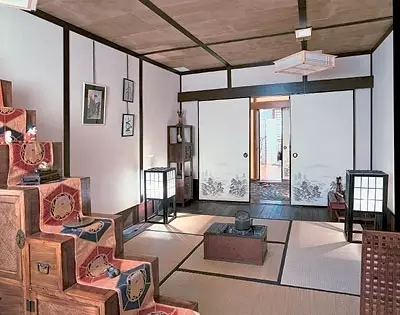
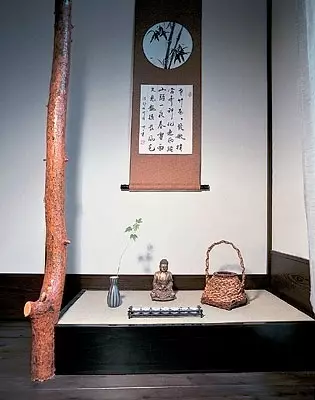
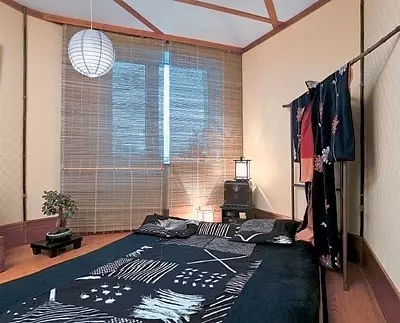
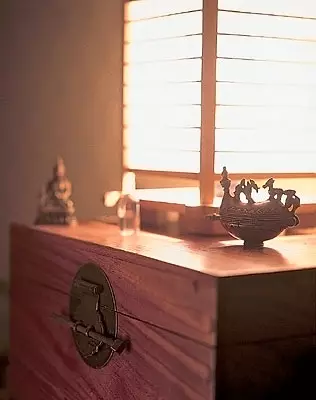
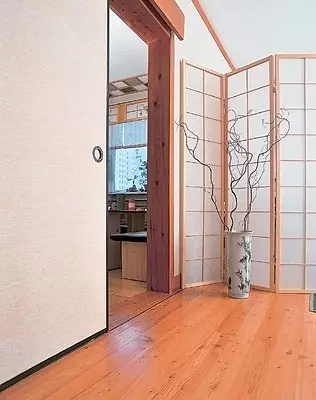
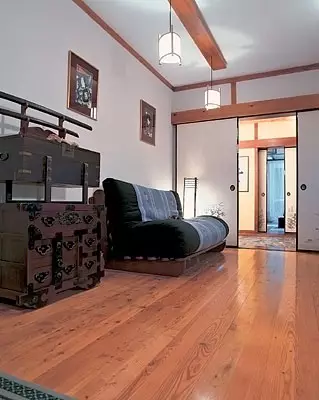
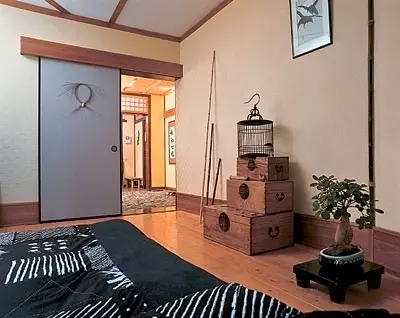
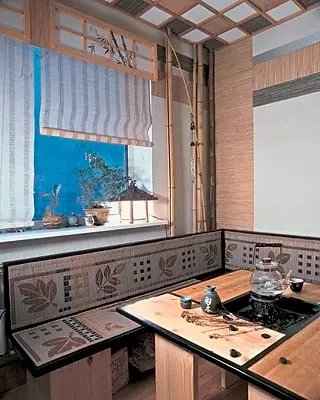
Penetration of Russian and Japanese traditions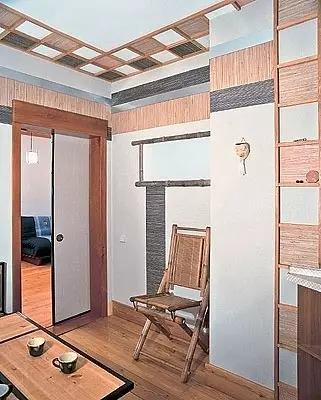
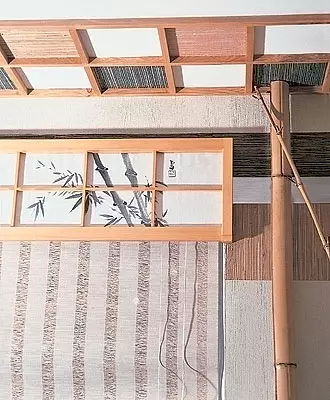
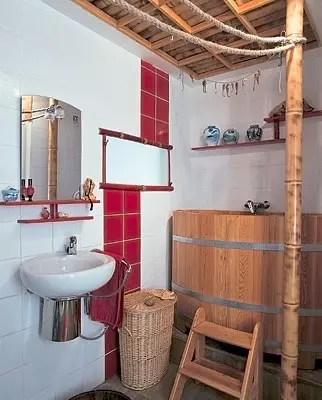

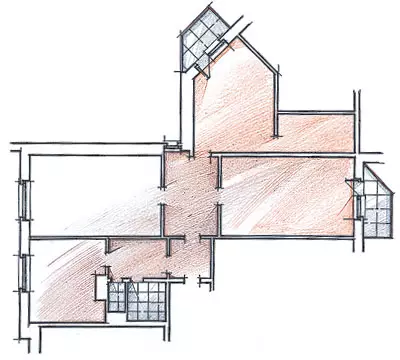
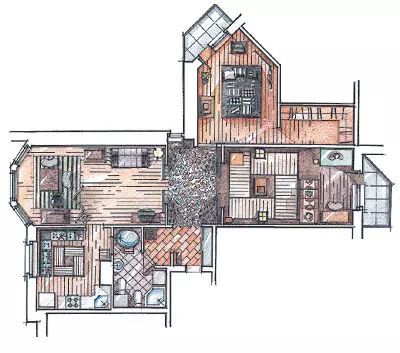
If you look at, in modern Russian everyday life, there are quite a few Japanese-Japanese restaurants, Iquiban in each showcase, martial arts, not to mention Japanese technology, from Player to the car. Often in their homes, people make up a Japanese-style room. Why is this distant country so closely connected in our thoughts with understanding of the beautiful? For two centuries, Europeans are fighting over this mystery. Form - Here it is, accessible to everyone, but the content ...
Morning shooting. While the usual fuss has not yet begun, He greets and enter the apartment. Holding a bag on a bamboo bench, in the mirror of the cabinet I see my little confused face. Bamboo trunks and round stones on the floor. According to them, perhaps, you will not pass on the hairpins ... unfamiliar music sounds. It seems that there are several interesting hours ahead and an excellent opportunity to at least understand something in mysterious Japanese culture and in the life of its adherents.
This 3-bedroom apartment with an area of 80m2 in the P-3M Model Type House was purchased three years ago. Bought it without finishing, made the usual redevelopment in such cases: combined the bathroom with the toilet, and the entrance to the kitchen was moved from the corridor to the living room. There were no more indigenous transformations. Next, it was necessary to decide how to finish the rooms. Since the hosts have long been seriously fascinated by the East, they wanted to build their new dwelling on the principles and laws of the traditional Japanese home. They helped them in this design decorator from the gallery "Zen-to" Nadezhda Smirnova and architect Vladimir Karelov.
Among the starting turmoil (without this shooting does not happen) I go around the apartment and try to navigate. From a small lounge with round stones on the floor, there are integer three rooms. One of them immediately attracts his eyes: complete extraordinary items, dark, with tatami on the floor, it is clearly intended for something important and mysterious. It seems that because of a discontinued door, it is about to come out with small marines a woman in kimono. Yes, this is a tea room, the most important in this house and in the traditional Dwelling of the Japanese. Nearby is a bedroom with a large pantry, curtained with a curtainer with a national Japanese ornament and puments that distinguishes evil spirits. The door to the spacious room with a sofa and a children's writing desk. I wonder what is the purpose of this room? Children? Living room? Snah borders the kitchen. From the hallway, bypassing a small lounge hall, you can get into the bathroom. That's the whole apartment.
It is easy to note that the interior is clearly divided into two zones - the external, "street" (here go to home shoes), and the inner, where they go barefoot or in Tabi-Japanese socks with a branch for thumb. The inner zone includes a tea room, a living room, a bedroom and a kitchen. In the external, the hall "courtyard", entrance hall and bathroom. In the inner zone, Paul Middle, in "Street", as it should be, Stone (stones, ceramic tiles, porcelain stoneware).
This division is not accidental. The main idea of the authors was to create a "courtyard", combining individual pavilions. After all, the rooms are here - independent, not completely interconnected spaces. Entering the apartment, you seem inside the Japanese Garden with all its attributes: stone lamps, tea house, trees, stones, etc. In general, for the Japanese, the garden at home means a lot. Even in large cities like Tokyo, where the density of the development is incredibly high, the family, if he has a block of land, will definitely plant a tiny tree on it and put a stone lantern.
Analyzing the planning, notice a funny, obviously "not a Russian" detail. The bathroom was in the outside zone, so to speak, "Naivilian". From the bedroom to the toilet, only by stones. Jicky warm floors. Women's floorboards, they are so warm. Avo "Dvorik" in heating stones is not necessary. For the Japanese is not characterized at all. Children in this country continue to walk in shorts even when the temperature outside the window decreases to 5 heat. But back to the location of the bathroom. Although it contradicts modern Moscow ideas, it is absolutely consistent with the Japanese tradition. The toilet is customary to equip in a remote, but picturesque corner of the garden, so that the beauty could somehow smooth the prosaic appointment of the structure.
In the piggy bank of ideas
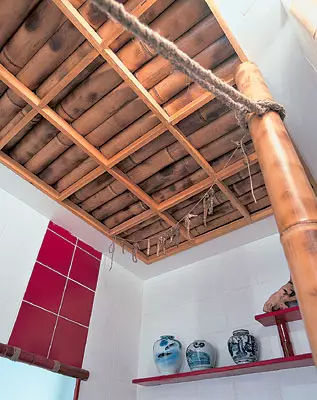
Unlike traditionally representative rooms, in which the ceiling is a spectacular plastic, one of the components of the front interior, the bathrooms can only boast of a modest choice of three-four finishing materials suitable for use in a humid environment. Yes, and they appeared on our market quite recently. Moisture-resistant plasterboard, stretch ceilings and metal or plastic racks, and all that can "shrink" bathrooms. True, in their complete disposal, the widest range of masterpieces of world design in the form of the most distinguished plumbing. But as for the ceiling finishes, here the horizons of designer fantasy are extremely narrowed.
But not in the interiors decorated in ethnic styles. Here, opportunities are expanding due to original, unusual finishing materials and elements.
The Japanese, living in a small house on the Nature Lon, uses a separate hut as a bathroom, hidden from prying eyes with thickets of bamboo or sakura. The owner of the Model Moscow apartment is doomed to standard amenities, but with amendments to the fiction of designers. Two thick bamboo trunks with stretched linen ropes "support" ceiling. The ceiling itself is also bamboo. A bamboo trunks of different diameters are lattice attached to the walls of impregnated pine wheels. For an additional decorative effect, they are slightly burned and polished. Bamboo perfectly transfers excess moisture indoors. After all, he grew up in a humid climate, the humidity for its native environment. Bamboo trunks do not absorb water and do not rot.
Slowly moving around the house, accompanied by hope, catching myself on the fact that everything only touches his hands. Here is a variety of textures! Rice Wallpaper with rice straw, polished wood, smooth bamboo trunks, thin, like dry skin, rice paper on width and window lattices, cold ceramics, mats ... texture is felt even feet: then a smooth wooden floor, then spring tatami, then a booming Bridge, then layered porcelain stoneware in the bathroom ...
We enter the courtyard. Under the legs, cold round stones of gray and brown (ordinary marine pebbles), above the bamboo heads with lanes laid on them. Side lights turns thin straws of mats into clear strokes on a white ceiling background. For some reason, the Crimean courtyards are remembered with ropes, seized grapes. It seems that the breeze will blow now. Vugl "Dvorika" - Stones and mushrooms stone lights, ordinary for the Japanese garden. The flat stone bowl, standing near, hints at the fact that the procedure is needed. We are trying to discard the vigor thoughts, since the transition from the outside is to be transmitted inside: a tea room ahead.
Tea ceremony (Japanese) is one of the ways to enlightenment in Zen-Buddhism. She passes in the tea pavilion or tea room. It can last long, sometimes for several hours. The master of the ceremony brews tea and offers a topic for reflection - it can be a veneer or landscape on a scroll hanging in a special ritual nichelocona. Guests drink tea, reflect on and communicate. Strictly painted canons encompass and pose during the seat, and the expression of the face, and a speech manner.
The transition from the outer zone to the home is marked by the drop of the surface of the surface, framing the pebbles in the "courtyard", 2-3cm above the stone. The entrance to the tea house is traditionally made low, 90cm high. Incoming should leave outside shoes, weapons (meaning a long samurai sword) and bow. Since the problem of weapons is not worth, leaning, pass through the sliding Japanese doors (fusum).
Before us is a tea room in four and a half tatami. Twilight. On the window-translucent linen curtains. On the floor, flush with a board perimeter, tatami was characteristic. The center is husting, on the coals of which the metal kettle is heated. I unwittingly look at the ceiling, looking for a wiggy spot. No, everything is clean. I do not understand anything. Above the head, between wooden slats, glitters gilded paper. In the lateral light, the inhomogeneity of its painting is noticeable, the paper looks old, shame, such as Japanese adore. They really appreciate the trace of time on the subject. It turns out that this is just a kraft-wrapping paper, which is covered with gold paint from the spray.
I can not get rid of the feeling that I am in the theater. Everything seemed to be deliberately done in order to hit the guest. The room is full of the most amazing items. Square floor lamps, a lacquer table, a shelf for a tea ceremony, a lot of things on the long litter of a stepped wardrobe - just eyes scatter! Against the background of monophonic walls, it all looks just luxurious.
I draw attention to the tree trunk at the window, standing in itself. It turns out that the tea ceremony requires a ritual nicheloconom in which a scroll with philosophical spinning is hanging and is worth a ikeban-extremely simple composition of colors. If there is no possibility to create a niche, there is a trunk of a tree to highlight a small survey of the total room.
Apparently, the tea room only remotely relates to a traditional tea pavilion, where, in addition to the toconom and items of the ceremony itself, nothing should be. ATEA premises - rather quintessence of all Japanese in the house. The same room is quite large, and tatami does not cover the entire area. On the remaining space at the owners window engaged in calligraphy. For this, a special table is installed. So, you can say, something similar to the office has been formed. Two zones of the room are divided by the famous Japanese step cabinet tanza.
Despite the fact that the appearance of modern Japanese apartments (most often one-room apartment) is little consistent with the aesthetics of a traditional Japanese house, with the slightest opportunity the Japanese are trying to preserve these ancient features.
A sunswer the only 12-meter room, which is a bedroom, and a dining room, and an office, and children, taken together, they are somewhere yes placing a toconom niche with a scroll and bouquet. Sometimes the composition is located even in the window opening.
Briefly look into the bedroom. On the wooden floor lie tatami, on their cotton mattress futon. The walls are monophonic, on the ceiling several diagonal wooden stripes. Two bowls lamp. Engraving. Everything is very simple. Translucent mats on the window seem to be air. The surrounding city is not visible, and you can imagine that you are in the mountains, and around on a lot of kilometers - deserted spaces, silence and air ... so calmly and intimate, that even awkwardly longly delay in it - it seems that I invaded the Forbidden zone.
The living room (at least guests here are accurately taken) a much brighter tea room, although there is no direct sun on the windows specially made grilles with rice paper inserts. Generally speaking, in the Japanese dwelling is usually rather dark, direct sunlight should not penetrate into it. This house is achieved not only by replacing the glass with opaque paper, but also due to the low sink of the roof. Shadow, half-ups, the natural atmosphere for the Japanese. In this case, the Moscow "Typovushka", of course, is much lighter. Almost white walls (wallpaper for painting), smooth white ceiling. On the floor, like everywhere in the apartment, - planks from larch. Thanks to the air layer between the boards and the concrete slab overlap (the boards lie on the lags) on the floor heat and cozy. As for the furniture, there are only vintage trunks (camphor tree), a traditional Japanese mattress, folded on a dub sofa, a small cabinet and a children's table on a small locker and a children's table. On a wide board hang filaments from wood and paper. Bamboo uokna-trunks with heating pipes hidden in them.
In the chests from camphoring tree in Japan, traditionally store clothing. This tree transmits your wonderful smell of fabrics (by the way, little similar on the smell of our camphor oil). Moreover, being in the chest, things pass bactericidal treatment, which is very important if the clothes (for example, expensive worsted kimono) rarely erase. The same camphor prevents the reproduction of various insects.
Looking around the circle, I can not "understand" this room. Japan and Russia were mixed with an amazing way. Objects all Japanese, extraordinary and sofa, and forged chest, and samurai swords, and painted doors. But, entering here, for some reason, quite clearly understand, the Russians live their own, Russians. A fond of Japanese culture is definitely. But the Russians. And this is due to this "Russianness", incomprehensible. Maybe the location of the items may, by the presence of an eternal pair "Sofa-TV", maybe the view outside the window. Anyway, there is clearly a lesser extent than in the bedroom, in the tea, and even in the "courtyard", there is this little snare Japanese home atmosphere.
In Russian tradition, we settle in the kitchen. We drink green tea from tiny cups. In the kitchen, light, mats, closing windows, rolled into rolls, light delay only low grilles with rice paper. On the ceiling and walls - greenish and beige stages of the material, on the texture similar to the mat. This is a rice straw wallpaper, purely Japanese material. They are simply attached, on glue for heavy wallpaper, but the result is very dependent on the thoroughness and accuracy of the operation.
Behind the conversation I consider a low square table with a deepening in the middle. Somewhere I have already seen it. Yes, it is four and a half tatami in the reduced version! Model of the room for a tea ceremony! I'm interested in where the table from? It turns out, he invented his mistress at home. Another invention is an angular sofa-bench on which we are sitting. They are made by masters from the gallery. The table and the sofa seat is somewhat higher than Japanese, but below the European standard. It turned out convenient for both Japanese meals and Russian. I measure: the height of the table - 61cm, seats, 40cm. Increasest cuisine is completely ordinary, Moscow. I feel in her as a fish in the water. In general, if the tea room is the most "Japanese" room apartment, then the kitchen is definitely the focus of Russian life. It would be surprising if it turned out otherwise.
In the kitchen wall, the window is breaking through the natural lighting of the bathroom. It is closed with matte glass. I remember that I heard somewhere that the Japanese peasants, coming home after work, first plunged into a wooden barrel with hot water, rested, relaxed, and then, throwing out fatigue, communicated with their homework. Is this tradition been respected here? Yes, indeed, there is a barrel for ablutions, and bought it in Moscow. The first thing that rushes into the bathroom is a wide box of bamboo stems painted in red. Thus closed all communications. The combination of red and white ceramic tiles on the walls, white plumbing and a large elliptical wooden barrel on the pedestal - everything is very bright and saturated. On the semi-rectangular tiles of the color stonework color of the old tree. This is a Japanese tradition of using natural shades and preferably from the natural components. Brown and red clay, brown and dark wood, black, white, gray stones, paper, gold is a set of shades of traditional Japanese interior.
* * *
Going home on the raw Moscow streets, I think about what you saw. What in this apartment is such an unusual penetrating in the soul? After all, Japanese style is fashionable for a long time, and therefore pretty beaten. Light walls, wooden lattices, mats, rice paper lamps - these things, simple and laconic, usually fit well into the modern interior, but for some reason the spirit of the rising sun is not transmitted. Why?
For each such thing it is much more than a naked function - it is worth a particular national spirit, the atmosphere, a mystery. Moreover, there is a feeling that, placed in the foreign environment, these items are falling asleep. They remain only a form. Like a shell without mollusk. Eastern exotic, for which we acquire them, disappears. Iones seem to be closed in themselves.
Is it possible to "Japan" in Russian soil? Probably possible. But only where they really live in Japanese. Idello is not in the house with chopsticks, whether there are mats and lanterns from rice paper (although, ultimately, and this is important). Japanese way of life is self-limitation, asceticism and collens, difficult to reach for a person of our culture. The well-known tea ceremony is 2-3 hours of concentration, and even on the floor. Few of us will endure such a goodwill.
The uniqueness of the house with whom we met is that they live here not "in the style" of Japan, but Her Spirit. Yes, to some extent, this is a Russian man's game anyway is not a Japanese. It is very fun to watch how in the process of the game Russian and the Japanese layers appear from each other. Is the same, this is the most serious game "to Japan" in the interior of a residential building, which I had to see.
Tatami-straw mat 5 cm thick, covered by the woven cloth from the cane IGU. It is sitting on it, they sleep on it. Tatami has a size of 18090cm. The Japanese still consider square meters in square meters, but tatami. "Room in 6thas" - such a phrase can be heard in modern Tokyo.
Fuseum-sliding Japanese door-partitions with a thickness of about 2 and a width of about 90cm (rice paper polystile). The height of the Fusum is much lower than our doors - only 180cm.
Hibacyrhem, on the coal of which heated water for tea and heating the room. If you use the purified Japanese coal in briquettes, then hibacy can be used in the closed room, such coal gives only heat, without smoke.
Foot-traditional Japanese mattress, packed with cotton. It is thick, heavy, does not fall and takes the uniform that he gives him. Foot preparations are used by raw cotton balls, which are manually separated from boxes and rejuvenated.
Toconomatual niche, the necessary attribute of a tea or residential room. The absence of a scroll - ca-mono with a philosophical spinning or landscape and flower arrangement - Iketubana.
The editors warns that in accordance with the Housing Code of the Russian Federation, the coordination of the conducted reorganization and redevelopment is required.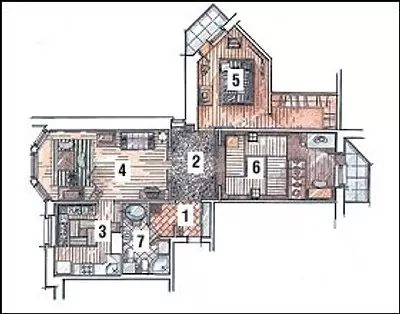
Architect: Vladimir Karelov
Designer: Nadezhda Smirnova
Designer: Notea Mariet
Watch overpower
